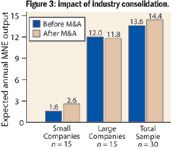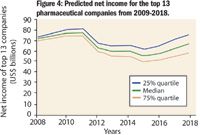How to Save Your Drug Company
Big thinker Bernard Munos delivers the goods.
"Industry is caught in a pincer between [a drug] output that is essentially linear, and likely to remain so, and a cost of producing [drugs] that is increasing exponentially. At some point, the situation will become untenable. This could tempt investors to force wholesale change onto the industry unless the industry pre-empts them with radical initiatives." So concludes Bernard Munos, a strategic advisor at Eli Lilly, in a recent Nature Reviews article on drug discovery. "Lessons from 60 years of Pharmaceutical Innovation" is a deep statistical dive into the performance of the integrated R&D model from 1950 to 2008, delivering an iconoclastic analysis, supported by surprising facts and provocative recommendations. Here we offer Munos' four main takeaways. To read the entire study, go to www.nature.com/reviews/drugdisc. —WA
STABLE PRODUCTIVITY
Figure 1: FDA approvals of new drugs, 1950–2008
Since 1950, a total of 1,222 new drugs (1,103 small molecules, 119 biologics) have come to market. The annual rate has remained surprisingly constant, except for a 15-year bump that peaked in 1996 when there were 51 approvals—a result of FDA clearing its big backlog. This long view contradicts received wisdom that productivity is cyclically depressed. "If nothing that drug companies have done in the past 60 years has succeeded in raising mean annual output, there is not a high probability that established strategies will change this now," Munos writes. "This suggests that this output … reflect[s] the innovative capacity of the established R&D model."

Figure 1
ESCALATING COST
Figure 2: Estimates of development cost of a new drug, 1950–2008
The industry's annual investment in R&D has grown dramatically over six decades, reaching $50 billion in 2008. Recently, the cost of bringing a single new drug to market has more than doubled, from $1.754 billion in 2000 to $3.911 billion (adjusted for post-approval R&D, new indications, non-US approvals; success rate; inflation; regulatory cost increases). Only 27 percent of all new drugs cost less than $1 billion to develop, while only 21 percent become blockbusters—a rate that has not improved over 20 years, despite the increasingly sophisticated sales forecasts and market analyses to increase predictions of success. This cost-to-productivity ratio is inadequate to secure the future of the industry, says Munos.

Figure 2
M&A vs. R&D
Figure 3: The average impact of M&A on small and large pharmas
Getting bigger has been no better at upping output than spending more. In fact, the Big Pharmas that have grown organically rather than through M&A activity have outperformed the high-dealing firms (based on an analysis of 24 acquisitions, six mergers, and 10-plus years of before-and-after data). "Only small companies show a slight, but significant, increase in new drug output. For large companies, M&As do not seem to create or destroy value.... [Their] impact can be summarized as 1 + 1 = 1," Munos writes. But industrywide consolidation could have an overall negative effect on productivity. Munos detected an unexpectedly close correlation between the number of new drugs produced and the number of companies operating in any given year. "A larger number of companies [may] accelerate the acquisition of knowledge, creating...a spillover—an industrywide benefit that enables all companies to be more productive."

Figure 3
THE FORECAST
Figure 4: Predicted income for the top 13 pharmas, 2009–2018
The patent cliff over which the industry is currently plunging is likely to result in a 5 to 10 percent loss in sales and a 20 to 30 percent loss in net income between 2012 and 2015. Sales should recover through 2018, but income may continue to suffer, clawing back only 5 percent. That scenario will make any pharma CEO tremble. "If the performance of the current business model cannot satisfy stakeholders, M&A are not a solution, and the process improvements and cost-cutting measures commonly used cannot make a sufficient difference, perhaps the industry ought to embrace a more radical change and seize the opportunity to redesign the model," writes Munos.

Figure 4
TO-DO LIST
» "Venture outside [the] comfort zone" when redesigning its engine of innovation.
» Embrace experiments like open-source R&D, innovation networks, and public-private partnerships to "harness the 'global brain" and access the best science.
» Increase the odds of breakthrough discoveries by creating "a separate, protected area the sole purpose of which is disruptive innovation."
» Cut back on the process culture that "create[s] little value in an industry dominated by blockbusters."
Addressing Disparities in Psoriasis Trials: Takeda's Strategies for Inclusivity in Clinical Research
April 14th 2025LaShell Robinson, Head of Global Feasibility and Trial Equity at Takeda, speaks about the company's strategies to engage patients in underrepresented populations in its phase III psoriasis trials.
Beyond the Prescription: Pharma's Role in Digital Health Conversations
April 1st 2025Join us for an insightful conversation with Jennifer Harakal, Head of Regulatory Affairs at Canopy Life Sciences, as we unpack the evolving intersection of social media and healthcare decisions. Discover how pharmaceutical companies can navigate regulatory challenges while meaningfully engaging with consumers in digital spaces. Jennifer shares expert strategies for responsible marketing, working with influencers, and creating educational content that bridges the gap between patients and healthcare providers. A must-listen for pharma marketers looking to build trust and compliance in today's social media landscape.
Pfizer, GSK Gain ACIP Recommendations for RSV and Meningococcal Vaccines
April 18th 2025The Centers for Disease Control and Prevention’s Advisory Committee on Immunization Practices voted to expand access to Pfizer’s respiratory syncytial virus vaccine Abrysvo for high-risk adults in their 50s and voted in favor of GSK’s meningococcal vaccine, Penmenvy, for streamlined adolescent protection.
